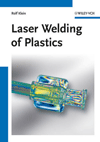
Laser sensors measure objects or distances in several ways. A time-of-flight system measures the time for a pulse of laser light to travel to a surface and return. Since the speed of light is constant, the sensor can calculate the distance. A through-beam system projects a wide column of laser light at a sensor. When an object interrupts the beam, the sensor determines its height or width by measuring its shadow.
However, for assembly applications, the most common technology is the laser triangulation sensor. This sensor consists of a pulsed laser and a linearized charge-coupled device (CCD). The CCD is located at an angle to the laser. The laser beam is projected onto the target as a spot or a line, and the light reflects back to the CCD at an angle. As the part moves past the laser (or vice versa), the position of the reflected light on the CCD moves, too. Measuring the latter thus provides an accurate measurement of the former.
Depending on the hardware and software, the sensor can provide point-to-point measurements or 2D profiles. The sensor can measure length, width, height and depth. Some sensors can find features as small as 0.002 inch. It can measure the radius of a curved part, the angle of intersecting parts, or the gap between mating parts. Because the laser pulses thousands of times per second, the sensor can also measure the frequency and amplitude of vibrations.
A laser triangulation sensor can be used in several ways. Mounted in a fixed position, it can measure parts as they pass by on a conveyor or indexing table. Alternatively, the sensor can be mounted directly to a machine to control motion. For example, the sensor can be attached to the Z axis of a Cartesian dispensing robot to control the height of the nozzle over the substrate. The sensor can also be integrated into a handheld measuring instrument.
In the electronics industry, triangulation sensors detect warped circuit boards, check connector pins for coplanarity, and measure the height of solder jets. A manufacturer of disk drives uses the sensor to measure the height of a lamp and the location of a head gimbal assembly. A manufacturer of digital cameras uses the sensor to measure the height of a CCD assembly. In the past, defective CCDs were only discovered during functional testing of finished cameras.
Aerospace manufacturers use handheld laser gauges to inspect the leading edge of turbine and compressor blades, says Brad Powell, technical director of Origin Technologies Corp. (Madison, AL). The gauges also ensure that the heads of countersunk fasteners are installed flush.
In automotive assembly, the sensor can inspect a bead of adhesive, measure vibration in disk rotors, and detect double-fed steel sheets prior to stamping. After stamping, the sensor can measure the curve of the part as well as the length and angle of the flange. The sensor can scan the length of a welded seam, looking for misalignments and cavities.
“The auto industry uses our handheld laser gauges to assess the fit and finish of a car,” adds Powell. “They measure the gap and flushness from door to door, hood to fender, and fender to door. ...They can’t do a continuous scan of every gap-that would be too time-consuming. But, they can take three or four measurements on each gap.”
Compared with other technologies for measuring parts, laser triangulation sensors offer several advantages, says Powell. They are easier to use than mechanical instruments, such as calipers and micrometers. Because laser sensors don’t contact the object to be measured, they can measure soft materials and thin-walled parts more accurately. A mechanical instrument could compress or distort pliable materials. Compared with coordinate measuring machines, laser sensors are more efficient, portable and affordable. A cordless, handheld laser gauging system weighs as little as 4 pounds and can be used anywhere in an assembly plant.



